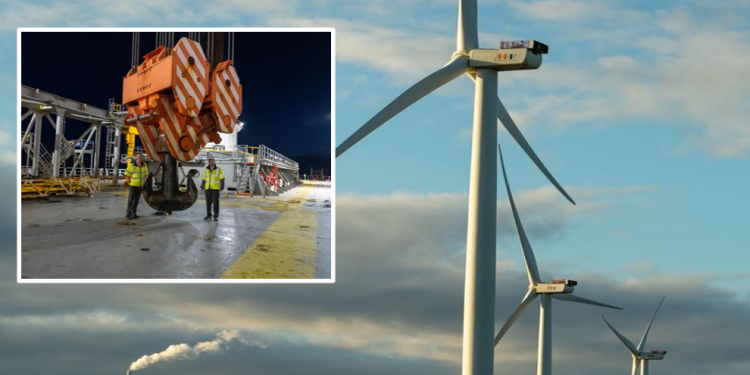In January 2023, Professors Willy Shih and Mike Toffel led more than 40 HBS MBA students on site visits to witness the energy transition and innovative sustainable production activities throughout Denmark and the Netherlands, in their new Immersive Field Course (IFC). This is one of 13 student essays posted on the HBS Business and Environment Initiative’s Blog that highlights their reflections. Learn more about this IFC course on Decarbonization and Sustainable Production by watching this five minute video summary.
Visit Date: January 3, 2023
Port Esbjerg, a key shipping hub in Denmark’s Jutland region on the North Sea, was one of our first visits as part of our immersive field course on decarbonization and sustainability. The port has been a leader in the offshore wind industry since they participated in the construction of the first large scale offshore wind farm in Denmark in 2002. Approximately 80% of Europe’s current offshore wind capacity has passed through the port. As the world seeks to reduce its reliance on fossil fuels, offshore wind is expected to play an increasingly important role in providing renewable energy. Experts predict offshore wind capacity will increase dramatically over the next decade, and Port Esbjerg plans to maintain its position as a key player in this growing industry.
Seeing the components up close
Our hosts at Port Esbjerg arranged an exciting afternoon for us to witness a wide variety of operations at the port. We began our tour with an up-close view of a set of wind turbines installed along the beach. Though installed on land, these were offshore turbines, which are typically bigger than their onshore counterparts. These land-based offshore turbines provide companies a means to quickly test updates to their offshore turbine systems without going all the way out to sea. We also met with a European utility company that is building a green hydrogen plant near these turbines. This new facility will soon take electricity generated by the turbines and convert it into green hydrogen to be used at the port and throughout Denmark. In addition to green hydrogen production, the facility also has plans for diverting excess electricity to provide additional supply.

Next on our tour, we climbed inside the nacelle of a wind turbine. The nacelle sits at the top of a turbine tower and houses the generator that converts the rotation of the turbine blades into electricity. One of the companies operating at the port had a huge number of nacelles lined up in the port waiting to be assembled into new turbines. The nacelle we went inside was the size of a small apartment and capable of producing 8 megawatts (MW) of electricity. Future turbine designs are expected to reach capacities well beyond 8 MW–roughly the amount of electricity an average American home consumes in a year.

We also visited the surveillance center of a large wind farm operator at the port. Running 24/7, the center monitors ships going to and from the turbines and crews working on them, as well as weather forecasts and energy demand forecasts to determine when to run the turbines. This visit provided us with a first-hand look at the complexity involved in keeping these turbines running.
We ended our tour with a visit onboard the Sea Challenger, a wind turbine service vessel. This massive ship has four columns installed at its corners that can be lowered into the sea floor to lift the ship entirely off the water. Once off the water, the ship’s 900-ton crane can install the turbine towers into the sea floor and assemble the nacelle and blades on top of the tower. Only a handful of these ships exist in the world, making this vessel a key enabler of new offshore wind projects.

Key takeaways
Through our site tour and discussion with subject matter experts, we were impressed by the huge potential of offshore wind as a clean energy source for the future not only in Denmark but across the globe. Offshore wind power generation is extremely complex, but we identified three key enablers for scaling up offshore wind that Port Esbjerg has put into practice.
Flexibility for electricity offtake. Offshore wind electricity generation fluctuates with the weather, not with consumer demand. Having multiple means of using this electricity, such as producing green hydrogen, helps absorb excess power and puts it to use. Furthermore, the ability to export green electricity to neighboring countries, as Denmark does, provides additional flexibility. These added benefits improve the effectiveness and efficiency of offshore wind.
Collaboration. Key players along the supply chain–from equipment manufacturers to operation and maintenance companies–must collaborate to maximize operational efficiencies. Public and private sector collaboration is also important for accelerating innovation. Port Esbjerg is a hub for collaboration, hosting all these key players at their facilities, gathering industrial expertise, and accelerating the sharing of innovative insights.
Regulatory support. Our hosts at Port Esbjerg work closely with Danish and European government institutions to stay on top of the latest demands for offshore wind and promote the rapid adoptions of new projects.
The visit to Port Esbjerg was a tremendous opportunity to deepen our understanding of the offshore wind energy landscape and to see first-hand the exciting work happening at Port Esbjerg.
-----
Read more posts in the IFC Series:
Deconstructing LEGO’s Decarbonization
Port Esbjerg: Deploying Offshore Wind
HySynergy and Crossbridge Energy
Grundfos: Innovation & Inspiration for Sustainable Product Design
Arla Foods: How Sustainable Can A Dairy Company Be?
Amager Bakke: A Look into the Future of Waste Incineration
Maersk’s Journey to Decarbonize Shipping
BTG Bioliquids: Creating Fast Pyrolysis Bio-Oil from Biomass Residue Streams
Grolsch Brewing Company: Drink Sustainably
Van den Ende Rozen: Greenhouse Rose Production

